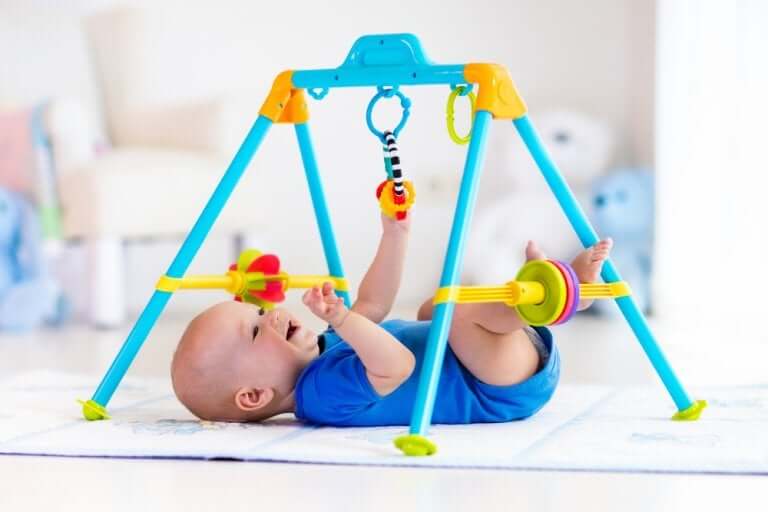Sensory Stimulation Activities at Home

The development of the baby’s brain is conditioned by the quantity and quality of the stimuli it perceives. Because of that, it’s important to stimulate our children’s brain mechanisms, so that they, in turn, activate other areas that allow the creation of new learning. For this reason, we’ve prepared this article on how to create sensory stimulation activities at home.
From home, you can offer experiences that provide pleasant sensations and positive benefits for your baby. There are different ways to perform sensory stimulation, but we’re going to focus on explaining some basic notions and activities.
Sensory stimulation activities
You should carry out stimulation activities in order for your children to begin to take an interest in themselves, in others, and also in their surroundings. You’ll work on three sensory areas when performing these types of exercises:
- Somatic: the ability to feel things through the skin
- Vestibular: the system that helps ensure balance and coordinate vision
- Vibratory: the ability to feel things inside our bodies from vibratory waves that can even be transmitted through voices
These three areas are the basis for a good development of the other senses, and they’re closely related to them. Using this, you can plan significant structured activities so that the child can feel their own body, develop their own identity, and also enter into a relationship with others and with their surroundings.

Sensory stimulation activities at home
At home you can prepare multi-sensory stimulation activities with common materials and carry out very simple activities. Below are some of them, each one specifying the main area that’s stimulated.
Dry baths
This is a somatic stimulation activity that enables a child to experience their own body. In order to carry it out, the child must be placed without clothes on, or with as few clothes as possible, in a small pool or bathtub filled with something that covers the child’s body. You can use something natural, such as vegetables, pasta, or rice, or something artificial, such as small balls.
This type of immersion can provide constant feedback between the child’s movement and their perception. This is because when the baby moves any part of their body, they can perceive it more easily thanks to the material that surrounds them.
Dry shower
We use this activity to stimulate the somatic area. It consists of placing the child under a table from which you can hang materials such as fabrics, feathers, wool, garlands, balloons, etc.
Small bells can also be placed at the end of the hanging objects, providing an acoustic-somatic response to the child’s movements and encouraging greater activity.
Hammock
This activity stimulates the vestibular system. To do this, the child is placed on a cloth hammock, close to the ground.
During the exercise, try to encourage the child to be as active as possible and to move every part of their body.
Ball with speakers
This activity stimulates the vibratory area. You need a ball with one or two speakers attached. Place the child on top of it, making it easier for them to perceive the vibrations transmitted by the entire surface of the ball.
Another element that facilitates the vibratory work with the ball is the possibility of favoring the relationship between movement and perception, accompanying the pre-established rhythm of the vibration with slight movements on the ball.

Working the 5 senses with sensory stimulation techniques at home
In addition to the basic areas of perception, at home you can also stimulate all 5 senses by performing very simple tasks. This stimulation can be carried out in the following ways:
- Acoustics: through heartbeats, variations of acoustic phenomena, use of instruments that emit sound, etc.
- Tacticle-haptic: with sensitization and desensitization of the palm of the hand, boards with different sensations, textures, etc.
- Visual: with games with lights, observation of black and white and color slides, etc.
- Oral: bringing objects to the child’s mouth that give sensations of cold and heat, offering objects to nibble on, etc.
- Taste: making it possible to try different flavors through liquids or sponges soaked in those liquids, through the taste of fruits, etc.
- Olfactory: bringing objects with pleasant aromas, oils, creams with scents, aromatic sacks, among others, close to their nose.
“Help your child experience all their senses. They’ll grow up to become someone who’s interested in the world around them.”
Benefits of sensory stimulation activities at home
There are children with special needs who require activities performed by specialized professionals and which focus on sensory stimulation. But, even so, they may require extra help at home. In these cases, it’s very useful to carry out these stimulating activities at home.
However, these activities are also very beneficial for babies who don’t have any special needs, as sensory stimulation is very important for a child’s overall development.
The development of the baby’s brain is conditioned by the quantity and quality of the stimuli it perceives. Because of that, it’s important to stimulate our children’s brain mechanisms, so that they, in turn, activate other areas that allow the creation of new learning. For this reason, we’ve prepared this article on how to create sensory stimulation activities at home.
From home, you can offer experiences that provide pleasant sensations and positive benefits for your baby. There are different ways to perform sensory stimulation, but we’re going to focus on explaining some basic notions and activities.
Sensory stimulation activities
You should carry out stimulation activities in order for your children to begin to take an interest in themselves, in others, and also in their surroundings. You’ll work on three sensory areas when performing these types of exercises:
- Somatic: the ability to feel things through the skin
- Vestibular: the system that helps ensure balance and coordinate vision
- Vibratory: the ability to feel things inside our bodies from vibratory waves that can even be transmitted through voices
These three areas are the basis for a good development of the other senses, and they’re closely related to them. Using this, you can plan significant structured activities so that the child can feel their own body, develop their own identity, and also enter into a relationship with others and with their surroundings.

Sensory stimulation activities at home
At home you can prepare multi-sensory stimulation activities with common materials and carry out very simple activities. Below are some of them, each one specifying the main area that’s stimulated.
Dry baths
This is a somatic stimulation activity that enables a child to experience their own body. In order to carry it out, the child must be placed without clothes on, or with as few clothes as possible, in a small pool or bathtub filled with something that covers the child’s body. You can use something natural, such as vegetables, pasta, or rice, or something artificial, such as small balls.
This type of immersion can provide constant feedback between the child’s movement and their perception. This is because when the baby moves any part of their body, they can perceive it more easily thanks to the material that surrounds them.
Dry shower
We use this activity to stimulate the somatic area. It consists of placing the child under a table from which you can hang materials such as fabrics, feathers, wool, garlands, balloons, etc.
Small bells can also be placed at the end of the hanging objects, providing an acoustic-somatic response to the child’s movements and encouraging greater activity.
Hammock
This activity stimulates the vestibular system. To do this, the child is placed on a cloth hammock, close to the ground.
During the exercise, try to encourage the child to be as active as possible and to move every part of their body.
Ball with speakers
This activity stimulates the vibratory area. You need a ball with one or two speakers attached. Place the child on top of it, making it easier for them to perceive the vibrations transmitted by the entire surface of the ball.
Another element that facilitates the vibratory work with the ball is the possibility of favoring the relationship between movement and perception, accompanying the pre-established rhythm of the vibration with slight movements on the ball.

Working the 5 senses with sensory stimulation techniques at home
In addition to the basic areas of perception, at home you can also stimulate all 5 senses by performing very simple tasks. This stimulation can be carried out in the following ways:
- Acoustics: through heartbeats, variations of acoustic phenomena, use of instruments that emit sound, etc.
- Tacticle-haptic: with sensitization and desensitization of the palm of the hand, boards with different sensations, textures, etc.
- Visual: with games with lights, observation of black and white and color slides, etc.
- Oral: bringing objects to the child’s mouth that give sensations of cold and heat, offering objects to nibble on, etc.
- Taste: making it possible to try different flavors through liquids or sponges soaked in those liquids, through the taste of fruits, etc.
- Olfactory: bringing objects with pleasant aromas, oils, creams with scents, aromatic sacks, among others, close to their nose.
“Help your child experience all their senses. They’ll grow up to become someone who’s interested in the world around them.”
Benefits of sensory stimulation activities at home
There are children with special needs who require activities performed by specialized professionals and which focus on sensory stimulation. But, even so, they may require extra help at home. In these cases, it’s very useful to carry out these stimulating activities at home.
However, these activities are also very beneficial for babies who don’t have any special needs, as sensory stimulation is very important for a child’s overall development.
All cited sources were thoroughly reviewed by our team to ensure their quality, reliability, currency, and validity. The bibliography of this article was considered reliable and of academic or scientific accuracy.
- Duch, R. y Pérez, C. (1995). La atención a los alumnos plurideficientes profundos: aportaciones desde el modelo de estimulación basal. En L. Arbea et al. (Ed.), La atención a alumnos con necesidades educativas graves y permanentes. Pamplona: Gobierno de Navarra, Departamento de Educación, Cultura, Deporte y Juventud.
- Roller, B. (1999). La estimulación basal y la importancia de la comunicación para el proceso de la individuación. Barcelona: Editorial Balmes II.
- Torres, S. (2015). La Ecuela Infantil: propuesta inclusiva para un alumnado con Parálisis Cerebral (Trabajo de Fin de Grado). Universidad de Internacional de la Rioja, Barcelona.
This text is provided for informational purposes only and does not replace consultation with a professional. If in doubt, consult your specialist.








